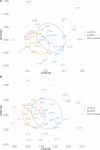Differences in the gut microbiota between Gurkhas and soldiers of British origin
- PMID: 38113233
- PMCID: PMC10729956
- DOI: 10.1371/journal.pone.0292645
Differences in the gut microbiota between Gurkhas and soldiers of British origin
Abstract
Previous work indicated that the incidence of travellers' diarrhoea (TD) is higher in soldiers of British origin, when compared to soldiers of Nepalese descent (Gurkhas). We hypothesise that the composition of the gut microbiota may be a contributing factor in the risk of developing TD in soldiers of British origin. This study aimed to characterise the gut microbial composition of Gurkha and non-Gurkha soldiers of the British Army. Recruitment of 38 soldiers (n = 22 Gurkhas, n = 16 non-Gurkhas) and subsequent stool collection, enabled shotgun metagenomic sequencing-based analysis of the gut microbiota. The microbiota of Gurkhas had significantly (P < 0.05) lower diversity, for both Shannon and Simpson diversity indices, using species level markers than the gut microbiota of non-Gurkha soldiers. Non-metric Multidimensional Scaling (NMDS) of the Bray-Curtis distance matrix revealed a significant difference in the composition of the gut microbiota between Gurkhas and non-Gurkha soldiers, at both the species level (P = 0.0178) and the genus level (P = 0.0483). We found three genera and eight species that were significantly enriched in the non-Gurkha group and one genus (Haemophilus) and one species (Haemophilus parainfluenzae) which were enriched in the Gurkha group. The difference in the microbiota composition between Gurkha soldiers and soldiers of British origin may contribute to higher colonization resistance against diarrhoeal pathogens in the former group. Our findings may enable further studies into interventions that modulate the gut microbiota of soldiers to prevent TD during deployment.
Copyright: © 2023 Troth et al. This is an open access article distributed under the terms of the Creative Commons Attribution License, which permits unrestricted use, distribution, and reproduction in any medium, provided the original author and source are credited.
Conflict of interest statement
TDT holds the position of Major in the British Army, and WvS offers consultancy services to companies with IP in microbiota therapeutics. This does not alter our adherence to PLOS ONE policies on sharing data and materials.
Figures



References
-
- Barrett J, Brown M. Diarrhoea in travellers. Medicine (Baltimore). 2018;46: 24–29.
-
- Kantele A, Kuenzli E, Dunn SJ, Dance DAB, Newton PN, Davong V, et al. Dynamics of intestinal multidrug-resistant bacteria colonisation contracted by visitors to a high-endemic setting: a prospective, daily, real-time sampling study. Lancet Microbe. 2021;2: e151–e158. doi: 10.1016/S2666-5247(20)30224-X - DOI - PMC - PubMed
MeSH terms
LinkOut - more resources
Full Text Sources
Medical

